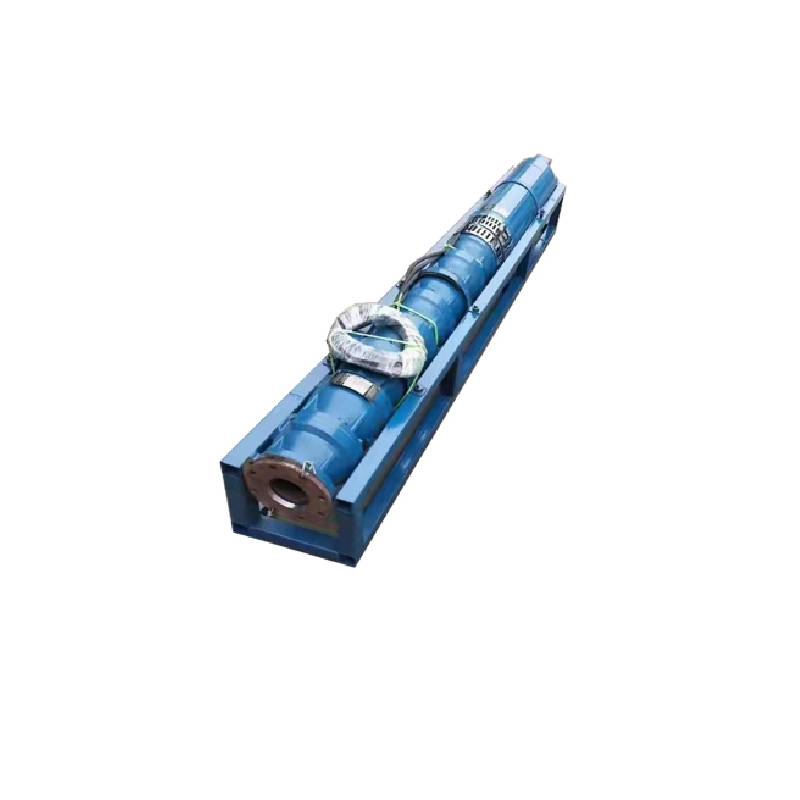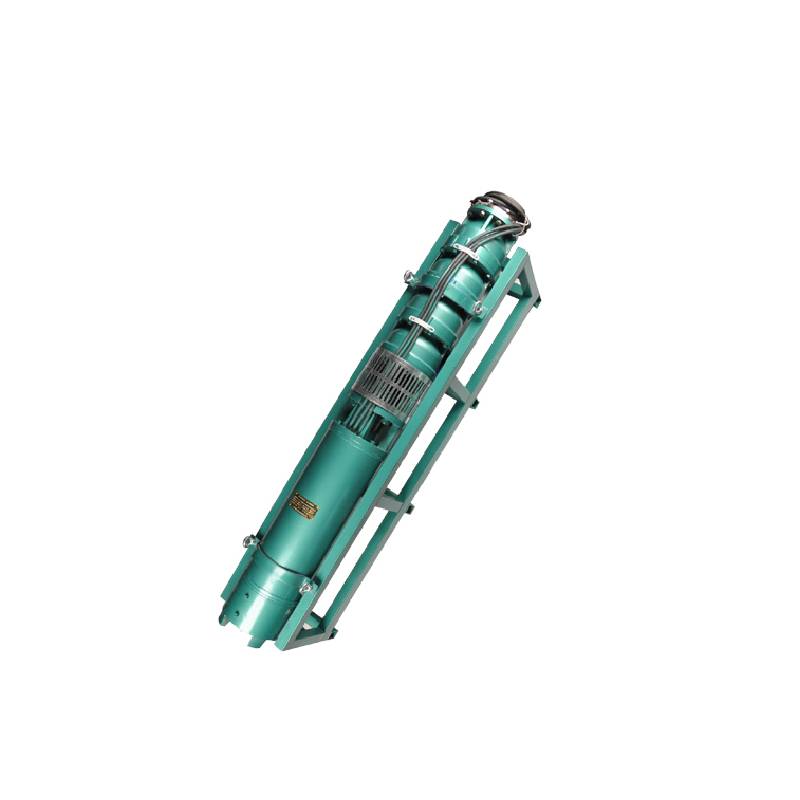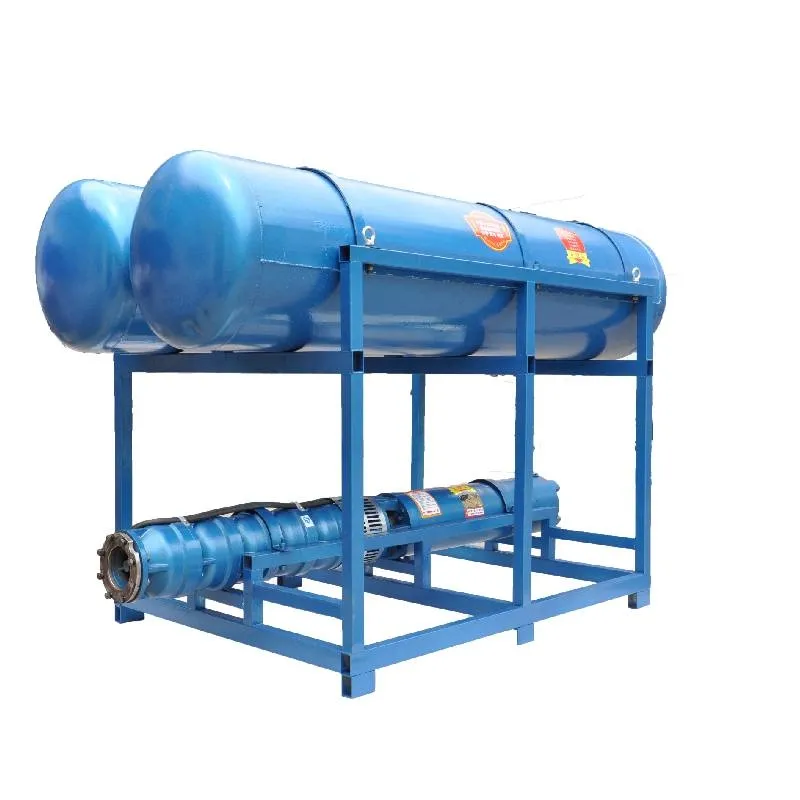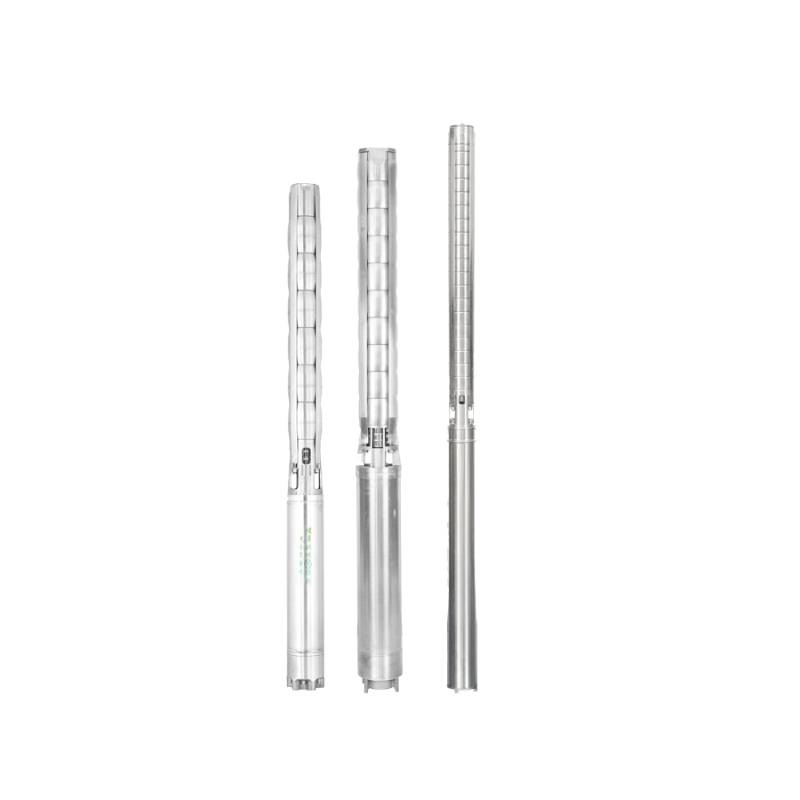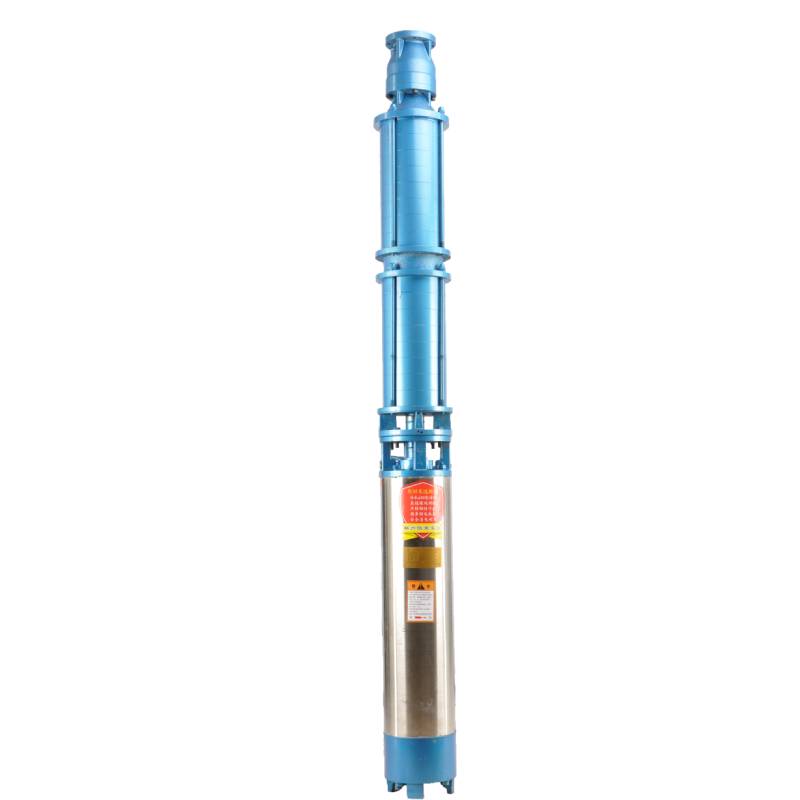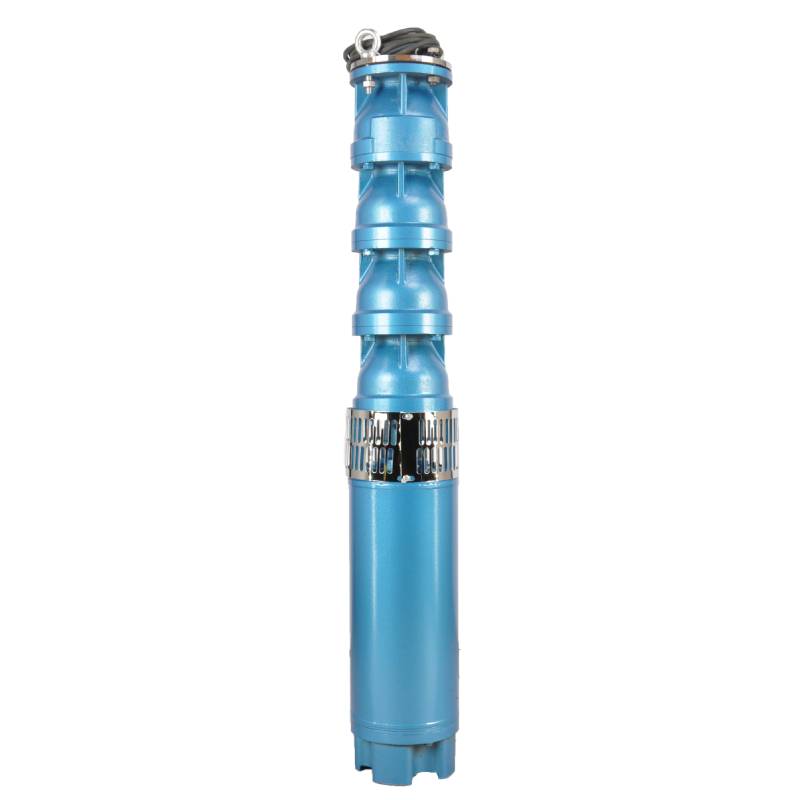QJP series special fountain pump is a special fountain pump developed by our factory. The pump motor core is made of high quality cold rolled silicon steel, which makes the pump more efficient, has good magnetic conductivity, and does not produce heat when starting frequently. The two ends of the motor rotor are covered with alloy copper sleeve as lubricant, using water. Stainless steel sleeves replace ball bearings, avoiding the problem of easy rust of ball bearings and the problem of motor burning due to lack of oil wear. It is very suitable for music fountain, all models can be used horizontally.
This product uses three-phase AC 380V power supply (tolerance + 5%), 50HZ frequency (tolerance + 1%); the applicable water quality conditions for water temperature is not higher than 20 °C, solid impurities content (mass ratio) is not more than 0.01%, pH value (pH) is 6.5-8.5, hydrogen sulfide content is not more than 1.5mg/L, chloride ion content is not more than 400mg/L. The motor adopts closed or water sealed wet structure, before use must be filled with clean water to prevent virtual filled, and then tighten the water injection and air exhaust bolts, otherwise not to use. Submersible pump must be completely immersed in water to work, immersion depth shall not exceed 70 meters, the distance between the bottom of the submersible pump and the bottom of the well shall not be less than 3 meters. The water in the well should be able to meet the water output and continuous operation of the submersible pump, the water output of the pump should be controlled at 0.7-1.2 times the rated flow. The well should be kept vertical, the submersible pump can not be used horizontally or overturned, only vertical installation. The submersible pump must be equipped with cables as required, and equipped with external overload protection device. The pump is strictly prohibited from no water load test.
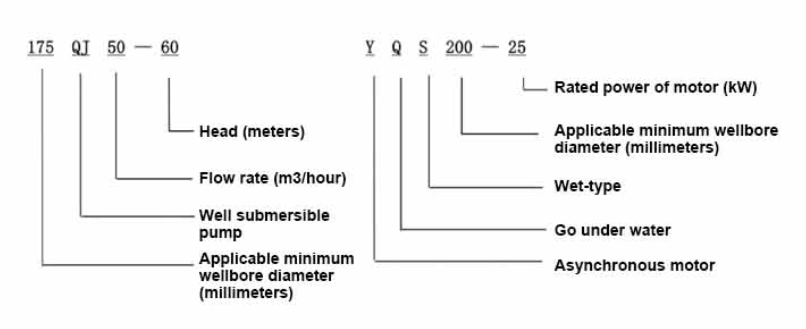
| Modelo | Caudal (m3/h) | Cabeza (metro) |
Velocidad de rotación (punto de cambio) |
Bomba de agua(%) | Salida diámetro (mm) |
Aplicable bien diámetro (mm) |
Clasificado power(KW) |
Clasificado voltaje(V) |
Clasificado corriente(A) |
Eficiencia motora (%) | power factorcosφ | Unidad Tamaño máximo radial (mm) |
Observación | |||||||||
| 200QJ20-40 | 20 | 40 | 2850 | 66 | 50 | 200arriba | 4 | 380 | 10.1 | 76.0 | 0.79 | 184 | ||||||||||
| 200QJ20-54 | 54 | 5.5 | 13.6 | 77.0 | 0.8 | |||||||||||||||||
| 200QJ20-81 | 81 | 7.5 | 18.0 | 78.0 | 0.81 | |||||||||||||||||
| 200QJ20-93 | 93 | 9.2 | 21.7 | 78.5 | 0.82 | |||||||||||||||||
| 200QJ20-108 | 108 | 11 | 25.8 | 79.0 | 0.82 | |||||||||||||||||
| 200QJ20-121 | 121 | 13 | 29.8 | 80.0 | 0.83 | |||||||||||||||||
| 200QJ20-148 | 148 | 15 | 33.9 | 81.0 | 0.83 | |||||||||||||||||
| 200QJ20-175 | 175 | 18.5 | 41.6 | 81.5 | 0.83 | |||||||||||||||||
| 200QJ20-202 | 202 | 22 | 48.2 | 82.5 | 0.84 | |||||||||||||||||
| 200QJ20-243 | 243 | 25 | 54.5 | 83.0 | 0.84 | |||||||||||||||||
| 200QJ20-270 | 270 | 30 | 65.4 | 83.0 | 0.84 | |||||||||||||||||
| 200QJ20-360 | 360 | 37 | 79.7 | 84.0 | 0.84 | |||||||||||||||||
| 200QJ20-442 | 442 | 45 | 96.9 | 84.0 | 0.84 | |||||||||||||||||
| 200QJ25-28 | 25 | 28 | 2850 | 68 | 65 | 200arriba | 4 | 380 | 10.1 | 76.0 | 0.79 | 184 | ||||||||||
| 200QJ25-42 | 42 | 5.5 | 13.6 | 77.0 | 0.8 | |||||||||||||||||
| 200QJ25-56 | 56 | 7.5 | 18.0 | 78.0 | 0.81 | |||||||||||||||||
| 200QJ25-70 | 70 | 9.2 | 21.7 | 78.5 | 0.82 | |||||||||||||||||
| 200QJ25-98 | 98 | 11 | 25.8 | 79.0 | 0.82 | |||||||||||||||||
| 200QJ25-112 | 25 | 112 | 2850 | 68 | 65 | 200arriba | 13 | 380 | 29.8 | 80.0 | 0.83 | 184 | ||||||||||
| 200QJ25-126 | 126 | 15 | 33.9 | 81.0 | 0.83 | |||||||||||||||||
| 200QJ25-154 | 154 | 18.5 | 41.6 | 81.5 | 0.83 | |||||||||||||||||
| 200QJ25-182 | 182 | 22 | 48.2 | 82.5 | 0.84 | |||||||||||||||||
| 200QJ25-210 | 210 | 25 | 54.5 | 83.0 | 0.84 | |||||||||||||||||
| 200QJ25-252 | 252 | 30 | 65.4 | 83.0 | 0.84 | |||||||||||||||||
| 200QJ25-308 | 308 | 37 | 79.7 | 84.0 | 0.84 | |||||||||||||||||
| 200QJ25-378 | 378 | 45 | 96.9 | 84.0 | 0.84 | |||||||||||||||||
| 200QJ32-26 | 32 | 26 | 2850 | 70 | 80 | 200arriba | 4 | 380 | 10.1 | 76.0 | 0.79 | 184 | ||||||||||
| 200QJ32-39 | 39 | 5.5 | 13.6 | 77.0 | 0.8 | |||||||||||||||||
| 200QJ32-52 | 52 | 7.5 | 18.0 | 78.0 | 0.81 | |||||||||||||||||
| 200QJ32-65 | 65 | 9.2 | 21.7 | 78.5 | 0.82 | |||||||||||||||||
| 200QJ32-78 | 78 | 11 | 25.8 | 79.0 | 0.82 | |||||||||||||||||
| 200QJ32-91 | 91 | 13 | 29.8 | 80.0 | 0.83 | |||||||||||||||||
| 200QJ32-104 | 104 | 15 | 33.9 | 81.0 | 0.83 | |||||||||||||||||
| 200QJ32-130 | 130 | 18.5 | 41.6 | 81.5 | 0.83 | |||||||||||||||||
| 200QJ32-143 | 143 | 22 | 48.2 | 82.5 | 0.84 | |||||||||||||||||
| 200QJ32-169 | 169 | 25 | 54.5 | 83.0 | 0.84 | |||||||||||||||||
| 200QJ32-195 | 195 | 30 | 65.4 | 83.0 | 0.84 | |||||||||||||||||
| 200QJ32-247 | 247 | 37 | 79.7 | 84.0 | 0.84 | |||||||||||||||||
| 200QJ32-299 | 299 | 45 | 96.9 | 84.0 | 0.84 | |||||||||||||||||
| 200QJ40-26 | 40 | 26 | 2850 | 72 | 80 | 200arriba | 5.5 | 380 | 13.6 | 77.0 | 0.8 | 184 | ||||||||||
| 200QJ40-39 | 39 | 7.5 | 18.0 | 78.0 | 0.81 | |||||||||||||||||
| 200QJ40-52 | 52 | 9.2 | 21.7 | 78.5 | 0.82 | |||||||||||||||||
| 200QJ40-65 | 65 | 11 | 25.8 | 79.0 | 0.82 | |||||||||||||||||
| 200QJ40-78 | 78 | 15 | 33.9 | 81.0 | 0.83 | |||||||||||||||||
| 200QJ40-104 | 104 | 18.5 | 41.6 | 81.5 | 0.83 | |||||||||||||||||
| 200QJ40-117 | 117 | 22 | 48.2 | 82.5 | 0.84 | |||||||||||||||||
| 200QJ40-143 | 143 | 25 | 54.5 | 83.0 | 0.84 | |||||||||||||||||
| 200QJ40-169 | 169 | 30 | 65.4 | 83.0 | 0.84 | |||||||||||||||||
| 200QJ40-208 | 208 | 37 | 79.7 | 84.0 | 0.84 | |||||||||||||||||
| 200QJ40-247 | 247 | 45 | 96.9 | 84.0 | 0.84 | |||||||||||||||||
| 200QJ50-26 | 50 | 26 | 2850 | 74 | 80 | 200arriba | 5.5 | 380 | 13.6 | 77.0 | 0.8 | 184 | ||||||||||
| 200QJ50-39 | 39 | 9.2 | 21.7 | 78.5 | 0.82 | |||||||||||||||||
| 200QJ50-52 | 52 | 11 | 25.8 | 79.0 | 0.82 | |||||||||||||||||
| 200QJ50-65 | 65 | 15 | 33.9 | 81.0 | 0.83 | |||||||||||||||||
| 200QJ50-78 | 78 | 18.5 | 41.6 | 81.5 | 0.83 | |||||||||||||||||
| 200QJ50-91 | 91 | 22 | 48.2 | 82.5 | 0.84 | |||||||||||||||||
| 200QJ50-104 | 104 | 25 | 54.5 | 83.0 | 0.84 | |||||||||||||||||
| 200QJ50-130 | 130 | 30 | 65.4 | 83.0 | 0.84 | |||||||||||||||||
| 200QJ50-156 | 156 | 37 | 79.7 | 84.0 | 0.84 | |||||||||||||||||
| 200QJ50-208 | 208 | 45 | 96.9 | 84.0 | 0.84 | |||||||||||||||||
| 200QJ63-24 | 63 | 24 | 2850 | 74 | 80 | 200arriba | 7.5 | 380 | 18.0 | 78.0 | 0.81 | 184 | ||||||||||
| 200QJ63-36 | 36 | 11 | 25.8 | 79.0 | 0.82 | |||||||||||||||||
| 200QJ63-60 | 60 | 18.5 | 41.6 | 81.5 | 0.83 | |||||||||||||||||
| 200QJ63-72 | 72 | 22 | 48.2 | 82.5 | 0.84 | |||||||||||||||||
| 200QJ63-84 | 84 | 25 | 54.5 | 83.0 | 0.84 | |||||||||||||||||
| 200QJ63-96 | 96 | 30 | 65.4 | 83.0 | 0.84 | |||||||||||||||||
| 200QJ63-120 | 120 | 37 | 79.7 | 84.0 | 0.84 | |||||||||||||||||
| 200QJ63-144 | 144 | 45 | 96.9 | 84.0 | 0.84 | |||||||||||||||||
| 200QJ80-22 | 80 | 22 | 2850 | 75 | 100 | 200arriba | 7.5 | 380 | 18.0 | 78.0 | 0.81 | 184 | ||||||||||
| 200QJ80-33 | 33 | 11 | 25.8 | 79.0 | 0.82 | |||||||||||||||||
| 200QJ80-44 | 44 | 15 | 33.9 | 81.0 | 0.83 | |||||||||||||||||
| 200QJ80-55 | 55 | 18.5 | 41.6 | 81.5 | 0.83 | |||||||||||||||||
| 200QJ80-66 | 66 | 22 | 48.2 | 82.5 | 0.84 | |||||||||||||||||
| 200QJ80-88 | 88 | 30 | 65.4 | 83.0 | 0.84 | |||||||||||||||||
| 200QJ80-99 | 99 | 37 | 79.7 | 84.0 | 0.84 | |||||||||||||||||
| 200QJ80-121 | 121 | 45 | 96.9 | 84.0 | 0.84 | |||||||||||||||||
| 200QJ100-18 | 100 | 18 | 2850 | 75 | 100 | 200arriba | 9.2 | 380 | 21.7 | 78.5 | 0.82 | 184 | ||||||||||
| 200QJ100-27 | 27 | 13 | 29.8 | 80.0 | 0.83 | |||||||||||||||||
| 200QJ100-36 | 36 | 18.5 | 41.6 | 81.5 | 0.83 | |||||||||||||||||
| 200QJ100-45 | 45 | 22 | 48.2 | 82.5 | 0.84 | |||||||||||||||||
| 200QJ100-54 | 54 | 25 | 54.5 | 83.0 | 0.84 | |||||||||||||||||
| 200QJ100-63 | 63 | 30 | 65.4 | 83.0 | 0.84 | |||||||||||||||||
| 200QJ100-72 | 100 | 72 | 2850 | 75 | 100 | 200arriba | 37 | 380 | 79.7 | 84.0 | 0.84 | 184 | ||||||||||
| 200QJ100-90 | 90 | 45 | 96.9 | 84.0 | 0.84 | |||||||||||||||||
Well submersible pump is a kind of fresh water pump, it is strictly prohibited to dig new wells and pump mud and sand. The product adopts 380/50HZ voltage grade, other voltage grades shall not be used, and the submersible motor needs to be customized. Underground cables must use waterproof cables, and must be equipped with starting equipment, such as distribution box, etc. The starting equipment shall have common motor comprehensive protection functions, such as short circuit overload protection, phase loss protection, undervoltage protection, grounding protection and no-load protection, etc. In abnormal cases, the protection device shall be tripped in time. When installed and used, the pump must be reliably grounded, it is prohibited to push and pull the switch when hands and feet are wet, and the power supply must be cut off before installation and maintenance of the pump. In the place where the pump is used, an obvious "anti-electric shock" sign must be set up. Before going down the well or installing, the motor must be filled with distilled water or non-corrosive clean cold water, and the water adding/discharge bolts must be tightened. When testing the pump on the ground, water must be injected into the pump chamber to lubricate the rubber bearings. The instantaneous start time shall not exceed one second to check whether the steering is correct, pay attention to safety, and prevent the pump from toppling and injuring people when it is upright. In strict accordance with the specified lift and flow range of the pump, to prevent the pump in low lift with large flow or in high lift with large traction, resulting in extreme wear of thrust bearings and other components, the motor overload and burn. After the pump into the well, the motor to the ground insulation resistance should be measured not less than 100MΩ. After the start, regular observation of voltage and current, and check whether the motor winding insulation meets the requirements; if the location of the pump storage temperature below freezing, should discharge the water in the motor cavity, to prevent water in the motor cavity ice and damage the motor due to low temperature.
Breve introducción de la estructura: la parte de la bomba se compone principalmente del eje de la bomba, el impulsor, la carcasa de desviación, el cojinete de goma, el cuerpo de la válvula de retención (piezas opcionales) y otros componentes. La parte del motor se compone principalmente de una base, una película reguladora de presión, un cojinete de empuje y una placa de empuje. , asiento del rodamiento guía inferior, estator, rotor, asiento del rodamiento guía superior, anillo de arena, sección de entrada de agua, cable y otros componentes.
Las principales características del producto incluyen:
1. El motor es un motor asíncrono trifásico sumergible húmedo lleno de agua, la cavidad del motor está llena de agua limpia, se usa para enfriar el motor y lubricar el rodamiento, la película reguladora de presión en la parte inferior del motor se usa para ajustar la diferencia de presión de expansión y contracción del agua dentro del cuerpo causada por el cambio en el aumento de temperatura del motor.
2. Para evitar que la arena del agua del pozo ingrese al motor, el extremo superior del eje del motor está equipado con dos sellos de aceite y se instala un anillo de arena para formar una estructura de prevención de arena.
3. Para evitar que el eje de la bomba suba al arrancar, el eje de la bomba y el eje del motor están conectados mediante un acoplamiento y se instala un cojinete de empuje superior en la parte inferior del motor.
4. La lubricación del motor y del cojinete de la bomba es lubricación con agua.
5. El devanado del estator del motor está hecho de alambre de bobinado de motor sumergible de alta calidad, con un alto rendimiento de aislamiento.
6. La bomba está diseñada mediante computadora CAD, con estructura simple y buen rendimiento técnico.

(1)Preparación antes de la instalación:
1. Verifique si la bomba sumergible cumple con las condiciones de uso y el alcance especificado en el manual.
2. Utilizando un objeto pesado con un diámetro igual al diámetro exterior máximo de la bomba sumergible, mida si el diámetro interior del pozo puede adaptarse a la bomba sumergible y mida si la profundidad del pozo cumple con los requisitos de instalación.
3. Verifique si el pozo está limpio y si el agua del pozo está turbia. Nunca utilice una bomba eléctrica sumergible para lavar el agua de lodo y arena de la bomba welor para evitar daños prematuros a la bomba eléctrica sumergible.
4. Compruebe si la posición de la abrazadera de instalación del cabezal de pozo es adecuada y si puede soportar la calidad de toda la unidad.
5. Verifique si los componentes de la bomba sumergible están completos e instalados correctamente de acuerdo con el diagrama de ensamblaje en el manual. Retire la pantalla del filtro y gire el acoplamiento para ver si gira con flexibilidad.
6. Desenrosque el tornillo de agua y llene la cavidad del motor con agua limpia y no corrosiva (nota: asegúrese de llenarla), luego apriete el tornillo de agua. Después de 12 horas de inyección de agua, la resistencia de aislamiento del motor no debe ser inferior a 150 M Q cuando se mide con una mesa vibratoria de 500 V.
7. Cable joint, cut off a 120mm rubber sleeve from one end of the outgoing cable and the matching cable with an electrician's knifethen stagger the length of the three core wires in a stepped shape, peel off a 20mm copper core, scrape of the oxide layer on theoutside of the copper wire with a knife or sand cloth, and insert the two connected wire ends in palirs.After tying the layer tightly with fine copper wire, solder it thoroughly and firmly, and sand of any. burrs on the surface. Then, forthe three joints, use polyvester insulation tape to wrap them in a semi stacked manner for three lavers. Wrap the two ends of thewrapping layer tightywith nyion thread,and then use a semi stacked method to wrap the tape for three layers. Wrap the outellayer with high-pressure insulation tape for three layers. Finally, fold the threestrands together and repeatedly wrap them for fivelayers with high-pressure tape. Each layer must be tightly tied, and the interlayer joints must be tight and fimm to prevent water frompenetrating and damaging the insulation, After wrapping, soak in water at room temperature of 20 ’c for 12 hours, and measurethe insulation resistance with a shaking table, which should not be less than 100M Ω
El diagrama del proceso de cableado del cable adjunto es el siguiente:
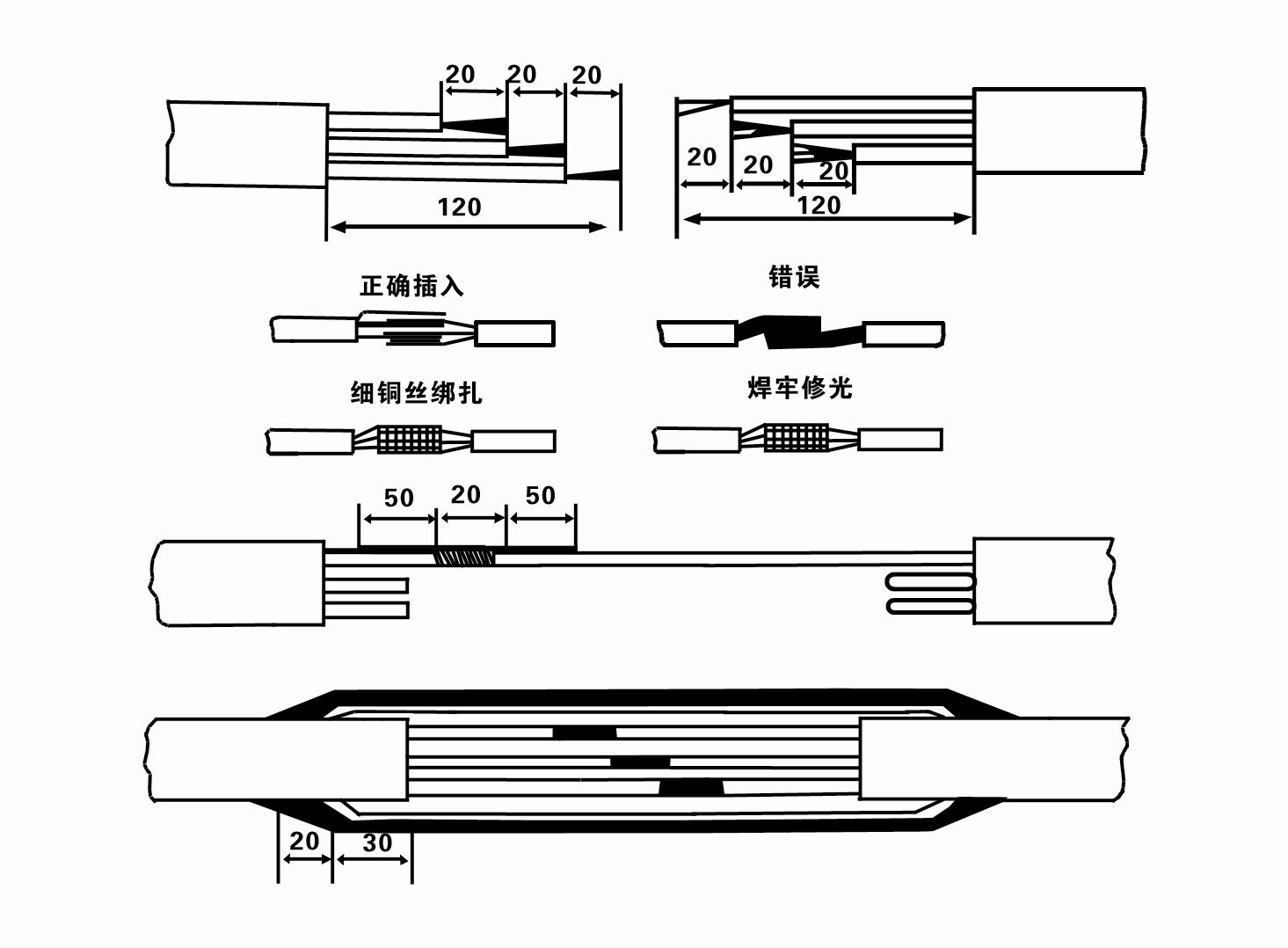
8. Utilice un multímetro para comprobar si los cables trifásicos están conectados y si la resistencia de CC está aproximadamente equilibrada.
9. Verifique si el circuito y la capacidad del transformador están sobrecargados y luego conecte el interruptor de protección contra sobrecarga o el equipo de arranque. Consulte la Tabla 2 para conocer modelos específicos y luego vierta un balde de agua en la bomba de agua desde la salida de la bomba de agua para lubricar los cojinetes de goma de la bomba y luego coloque la bomba eléctrica sumergible en posición vertical y estable. Inicio (no más de un segundo) y compruebe si la dirección de dirección es consistente con la señal de dirección. De lo contrario, cambie los dos conectores del cable trifásico. Luego instale el filtro y prepárese para bajar al pozo. Si se utiliza en ocasiones especiales (como zanjas, acequias, ríos, estanques, estanques, etc.), la bomba eléctrica debe estar conectada a tierra de manera confiable.
(2) Equipos y herramientas de instalación:
1. Un par de cadenas de elevación para más de dos toneladas.
2. Un trípode con una altura vertical no inferior a cuatro metros.
3. Dos cuerdas para colgar (cables de alambre) que pueden soportar un peso de más de una tonelada (pueden soportar el peso de un juego completo de bombas de agua).
4. Instale dos pares de abrazaderas (férulas).
5. Llaves, martillos, destornilladores, herramientas e instrumentos eléctricos, etc.
(3)Instalación de bomba eléctrica:
1. El diagrama de instalación de la bomba eléctrica sumergible se muestra en la Figura 2. Las dimensiones de instalación específicas se muestran en la Tabla 3 "Lista de dimensiones de instalación de la bomba eléctrica sumergible".
2. Las bombas eléctricas sumergibles con una altura inferior a 30 metros se pueden izar directamente al pozo utilizando mangueras y cables metálicos u otros cables de cáñamo que puedan soportar todo el peso de toda la máquina, las tuberías de agua y el agua en las tuberías.
3. Las bombas con una altura de más de 30 metros utilizan tuberías de acero y la secuencia de instalación es la siguiente:
①Utilice una abrazadera para sujetar el extremo superior de la parte de la bomba de agua (el motor y la bomba de agua se han conectado en este momento), levántelo con una cadena colgante y átelo lentamente al pozo hasta que coloque la abrazadera en la boca del pozo y retire la cadena colgante.
② Utilice otro par de abrazaderas para sujetar un tubo, levántelo con una cadena colgante a 15 cm de la brida y bájelo lentamente. Entre la brida de la tubería y la brida de la bomba Coloque la almohadilla de goma en su lugar y apriete la tubería y la bomba de manera uniforme con pernos, tuercas y arandelas de resorte.
③ Levante ligeramente la bomba sumergible, retire la abrazadera en el extremo superior de la bomba de agua, ate el cable firmemente a la tubería de agua con una cinta plástica y átelo lentamente hasta que la abrazadera quede colocada en la boca del pozo.
④Utilice el mismo método para conectar todas las tuberías de agua al pozo.
⑤Después de conectar el cable de salida al interruptor de control, se conecta a la fuente de alimentación trifásica.
(4) Cosas a tener en cuenta durante la instalación:
1. Si se encuentra un fenómeno de atasco durante el proceso de bombeo, gire o tire de la tubería de agua para superar el punto de atasco. Si varias medidas aún no funcionan, no fuerce la bomba hacia abajo para evitar daños a la bomba eléctrica sumergible y al pozo.
2. Durante la instalación, se debe colocar una almohadilla de goma en la brida de cada tubería y apretarla uniformemente.
3. Cuando la bomba de agua se baja al pozo, debe colocarse en el medio de la tubería del pozo para evitar que la bomba funcione contra la pared del pozo durante mucho tiempo, lo que hace que la bomba vibre y el motor barre y quema. .
4. Determine la profundidad de la bomba de agua hasta el fondo del pozo de acuerdo con las condiciones del flujo de arena y limo del pozo. No entierre la bomba en el barro. La distancia desde la bomba de agua hasta el fondo del pozo generalmente no es inferior a 3 metros (ver Figura 2).
5. La profundidad de entrada de agua de la bomba de agua no debe ser inferior a 1-1,5 metros desde el nivel dinámico del agua hasta el nodo de entrada de agua (consulte la Figura 2). De lo contrario, los cojinetes de la bomba de agua podrían dañarse fácilmente.
6. La elevación de la bomba de agua no puede ser demasiado baja. De lo contrario, se debe instalar una válvula de compuerta en la tubería de agua de la boca del pozo para controlar el flujo de la bomba en el punto de flujo nominal y evitar que el motor se sobrecargue y se queme debido a grandes caudales.
7. Cuando la bomba de agua está funcionando, la salida de agua debe ser continua y uniforme, la corriente debe ser estable (en condiciones de trabajo nominales, generalmente no más del 10% de la corriente nominal) y no debe haber vibraciones ni ruidos. Si hay alguna anomalía, se debe detener la máquina para descubrir la causa y eliminarla.
8. Al realizar la instalación, preste atención a la configuración del cable de tierra del motor (consulte la Figura 2). Cuando la tubería de agua sea de acero, condúzcala desde la abrazadera del cabezal del pozo; Cuando la tubería de agua sea de plástico, condúzcala desde la marca de conexión a tierra de la bomba eléctrica.
- 1. Después de instalar la bomba sumergible, verifique nuevamente la resistencia de aislamiento y la conducción trifásica desde el interruptor, verifique si el instrumento y la conexión del equipo de arranque están incorrectos, si no hay ningún problema, se puede iniciar la máquina de prueba. y observe si las lecturas del indicador del instrumento exceden el voltaje y la corriente nominales especificados en la placa de identificación después del arranque, y observe si la bomba tiene fenómenos de ruido y vibración, y póngala en funcionamiento si todo es normal.
- 2. Después de la primera operación de la bomba durante cuatro horas, el motor debe apagarse para probar rápidamente la resistencia del aislamiento térmico y su valor no debe ser inferior a 0,5 megaohmios.
- 3. Después de apagar la bomba, se debe arrancar después de cinco minutos para evitar que la columna de agua en la tubería vuelva a fluir por completo y cause una corriente excesiva del motor y que se queme.
- 4. Después de que la bomba entre en funcionamiento normal, para prolongar su vida útil, es necesario comprobar regularmente si el voltaje de suministro, la corriente de trabajo y la resistencia de aislamiento son normales. Si se encuentran las siguientes condiciones, la bomba debe apagarse inmediatamente para solucionar el problema.
- 1 In the rated condition, the current exceeds 20%.
- 2 El nivel dinámico del agua cae a la sección de entrada de agua, provocando agua intermitente.
- 3 La bomba sumergible tiene fuertes vibraciones o ruidos.
- 4 La tensión de alimentación es inferior a 340 voltios.
- El fusible de 5 A está quemado.
- 6 La tubería de suministro de agua está dañada.
- 7 The motor's thermal insulation resistance is lower than 0.5 megaohm.
- Unit disassembly:
- 1.Untie the cable tie, remove the pipeline part, and remove the wire plate.
- 2.screw down the water bolt, put the water in the motor chamber.
- 3.remove the filter, loose the fixed screw on the coupling to fix the motor shaft.
- 4.screw down the bolt connecting the water inlet section with the motor, and separate the pump from the motor (pay attention to the unit cushion when separating, to prevent the bending of the pump shaft)
- 5.the disassembly sequence of the pump is: (see figure 1) water inlet section, impeller, diversion shell, impeller...... check valve body, when removing the impeller, use special tools to loosen the conical sleeve of the fixed impeller first, and avoid bending and bruising the pump shaft in the process of disassembly.
- 6.the disassembly process of the motor is: (see figure 1) place the motor on the platform, and remove the nuts, base, shaft head locking nut, thrust plate, key, lower guide bearing seat and double head bolt from the bottom of the motor in turn, and then take out the rotor (pay attention not to damage the wire package) and finally remove the connecting section and upper guide bearing seat.
- 7.unit assembly: before assembly, the rust and dirt of the parts should be cleaned, and the mating surface and fasteners coated with sealant, and then assembled in the opposite order of disassembly (the motor shaft moves up and down after assembly for about one millimeter), after assembly, the coupling should be flexible, and then the filter screen test machine. Submersible pumps shall be taken out of the well for dismantling and maintenance according to Article 5 after a year of operation, or less than a year of operation but two years of diving time, and the worn parts shall be replaced.
This product is a submersible pump, which is suitable for various water areas, such as home, agriculture and industry.In order to prevent the motor from freezing in winter, be sure to discharge all the water in the pump chamber, and roll and tie the cable well.In addition, a room without corrosive substances and gases and with a temperature below 40 °C should be selected for storage.When not in use for a long time, special attention should be paid to the rust prevention of the submersible pump.This product is exquisitely designed and convenient to use, which can help users efficiently deal with various water needs, and is an ideal choice for your home and industrial water.
- Impulso
- Camisa del eje
- Manguito de eje de goma
-
anillo de sellado
01 Toma de agua de pozo profundo
02 Suministro de agua en altura
03 suministro de agua de montaña
04 torre de agua
05 Riego agrícola
06 riego de jardines
07 toma de agua del río
08 agua sanitaria

